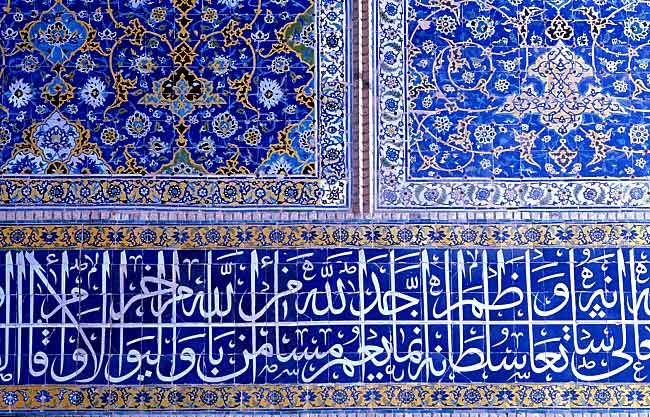Isfahan Calligraphy

The Arabic script was adopted in Iran quite soon after the Islamic conquest of AD 642, largely because it was the official script of the new state into which Iran was incorporated.Calligraphy is the highest art form of the Islamic civilization, and like all forms of art that came into contact with Iran, it was enhanced and developed by the Persians. It was practised not only by professional calligraphers, but also by princes and nobles themselves. Calligraphers were an essential requirement for any self-respecting court, both to instruct the prince's children in the principles of the art and to produce manuscripts for the royal library.Under the Timurids and the Safavids, calligraphy experienced perhaps its most brilliant development. In the late 14th century Umar Aqta "with amputated hand", wrote a miniature Koran for Timur, which was so small that it could be fitted under the socket of a signet ring. When Timur disapproved of it because, according to a Prophetic tradition the Word of God should be written in big letters, the calligrapher produced another copy in which each was a cubit1 in length.The application of calligraphy to architectural surfaces also reached new heights during this period with entire surfaces of mosques covered with coloured tiles bearing decoration and magnificent calligraphic inscriptions. The Friday Mosque in Isfahan can be regarded as a model for every possible style of calligraphic decoration, beginning with the network of plaited Kufi in Oljeitu's prayer niche which is crowned by highly involved thuluth on a floral background and culmulating in large panels of elegant thuluth inscriptions of the 17th century.By the 16th century, Shiraz was among the forerunners of calligraphy study and production in the Islamic world; followed by Isfahan.Persian calligraphers excelled in all styles of writing; the elegant large muhaqqaq, the finer rihani, and the heavy pliable thuluth script to name a few. The art of calligraphy was much more than simply noting down texts. The calligrapher's pen, made from reed and according to strict rules was considered to be the 'cypress in the garden of knowledge'.Calligraphy was regarded as an expression of man's spiritual state; for 'purity of writing proceeds from purity of heart' (Sultan Ali Mashhadi); therefore the calligrapher had to undergo observances similar to those of the holy person.In the early centuries, the style of writing was quite uniform throughout the Moslem World.The Arabic script was derived from the Syriac and the Nabatean, which is characterised by a contrast between vertical lines and the horizontal based line formed by the links between the letters. The artistic potential of this system was exploited very early on, and a large range of different scripts have evolved over the centuries.
(1).jpg)
FAMOUS CALLIGRAPHERS IN SAFAVID PERIOD
ALI REZA ABBASI
Ali Reza Abbasi (1565-1634) is one of the most prominent calligraphers of Safavid period. He was born in Kashan. As soon as he was a remarkable calligrapher he left Kashan to Isfahan . He was introduced to Shah Abbas the first’s court. Soon he was honored by title of “Abbasi”. He was employed by Shah’s court, but he left the court soon.In 1610 he came back to the court and worked there until his death. He died in 1634. He was a wonderful miniaturist too. A part of reception hall of the Ali Qapu palace was decorated with his beautiful unique miniatures on stucco work. A lot of his work can be seen in Iranian museums and important museums of the west such as Louver and Metropolitan museums.
MIR EMAD
Mir Emad (1556-1615) was one of the most celebrated Iranian calligraphers. Nostalgic calligraphy reached its Zenith by wonderful works of Mir Emad. He was born in Qazvin and he was educated there too.Mir Emad traveled to Tabriz in order to develop his knowledge and art. He studied with Mohammad Hossein Tabrizi. He was invited to the court of Shah Abbas 1. He tried to train his son and daughter as calligraphers, but his decedents did not reach as high as Mir Emad. A part of Sheick Lotfollah Mosque’s inscriptions was implemented by Mir Emad.There was a sever competition between Mir Emad and Ali Reza Abbasi. Ali Reza Abbasi, although he was a great artist and calligrapher but his hostility against Mir Emad consequenced to the execution of Mir Emad. In order to defame Mir Emad, he was accused of being Sunnite. Several people were executed by the order of Shah Abbas the first. His innocent son and Mir Emad were two of these unfortunate persons.
.....
.....
.....

.jpg)



























